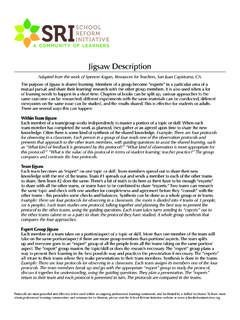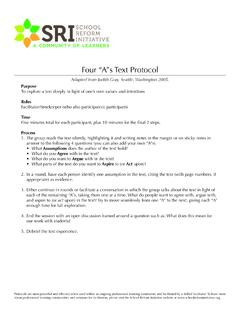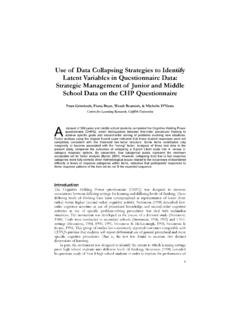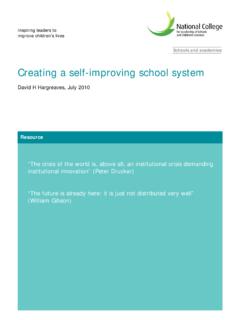Transcription of Data Driven Dialogue - School Reform Initiative
1 Protocols are most powerful and effective when used within an ongoing professional learning community and facilitated by a skilled facilitator. To learn more about professional learning communities and seminars for facilitation, please visit the School Reform Initiative website at Driven DialogueDeveloped by the Teacher Development Group, 2002. Based on work presented by Nancy Love, author of Using data /Getting Results, 2002. Dialogue comes from the Greek word dialogos. Logos means the word, or in our case we would think of the meaning of the word.
2 And dia means through it doesn t mean two. A Dialogue can be among any number of people, not just two. Even one person can have a sense of Dialogue within himself, if the spirit of Dialogue is present. The picture or image that this derivation suggests is of a stream of meaning flowing among and through us and between us. This will make possible a flow of meaning in the whole group, out of which will emerge some new understanding. It s something new, which may not have been in the starting point at all. It s something creative.
3 And this shared meaning is the glue or cement that holds people and societies together, (Bohm, D., 1990).This protocol builds awareness and understanding of the participant s viewpoints, beliefs, and assumptions about data while suspending judgments. All participants have equal voice. The 3 phases of data - Driven Dialogue assist groups in making shared meaning of data . We encourage you to use this tool with your entire School staff and/or with your School leadership team at a special meeting on data . The Dialogue tool helps to replace hunches and feelings with data -based facts, examine patterns and trends of performance indicators, and generate root-cause discussions that move from identifying symptoms to possible causes of student performance.
4 In order to effectively use this tool, participants will need to have grade level, School , or district data reports. Phase I PredictionsSurfacing perspectives, beliefs, assumptions, predictions, possibilities, questions, and expectations. Phase II Go VisualRe-create the data visually. Phase III ObservationsAnalyzing the data for patterns, trends, surprises, and new questions that jump out. Phase IV InferencesGenerating hypotheses, inferring, explaining, and drawing conclusions. Defining new actions and interactions and the data needed to guide their implementation.
5 Building ownership for protocol and facilitation, see data Driven Dialogue Protocol Facilitation are most powerful and effective when used within an ongoing professional learning community and facilitated by a skilled facilitator. To learn more about professional learning communities and seminars for facilitation, please visit the School Reform Initiative website at Driven DialoguePhase I PredictionsPhase I Predictions Dialogue takes place before you see the data . During this time, you activate prior knowledge, surface assumptions, and make predictions, thus creating readiness to examine and discuss the data .
6 You hear and honor all assumptions and ideas as building blocks for new learning. Private Think TimeBefore beginning your Phase I Predictions Dialogue , please reflect privately and record several of your preliminary thoughts about the data . One or more of the following thought-starters may be helpful. I I I My questions/expectations are influenced Some possibilities for learning that this data may are most powerful and effective when used within an ongoing professional learning community and facilitated by a skilled facilitator.
7 To learn more about professional learning communities and seminars for facilitation, please visit the School Reform Initiative website at Driven DialoguePhase II Go VisualDuring Phase II Go Visual you re-create the data visually, on large sheets of paper, on a data wall, etc. Participants mark up the data so they better understand it ( , highlight trend lines in different colors, do math calculations and chart those, color code parts of the data that relate to each other). Participants might create visuals individually or in pairs or triads.
8 Depending upon the amount of data , it might be helpful to divide it into subsets and identify who in the group will work with different are most powerful and effective when used within an ongoing professional learning community and facilitated by a skilled facilitator. To learn more about professional learning communities and seminars for facilitation, please visit the School Reform Initiative website at Driven DialoguePhase III ObservationsDuring Phase III Observations Dialogue , you engage with the actual data and note only the facts that you can observe in the data .
9 Conjectures, explanations, conclusions, and inferences are off-limits. You make statements about quantities ( , Over half the ), the presence of certain specific information and/or numerical relationships between ideas ( , Over 90% of the students achieved below standard in Problem Solving; Compared to last year s data , the percentage of students performing at the advanced and on-standard levels in Skills increased by 8%..).Private Think TimeBefore beginning Phase III Observations Dialogue , please study the data privately and record several of your :Just the facts!
10 If you catch yourself using the following words, then stop. It I observe Some patterns/trends that I I can I m surprised that I are most powerful and effective when used within an ongoing professional learning community and facilitated by a skilled facilitator. To learn more about professional learning communities and seminars for facilitation, please visit the School Reform Initiative website at Driven DialoguePhase IV InferencesDuring Phase IV Inferences Dialogue , you (a) generate multiple explanations for your Phase III Observations; (b) identify additional data that may be needed to confirm/contradict your explanations; (c) propose solutions/responses.













